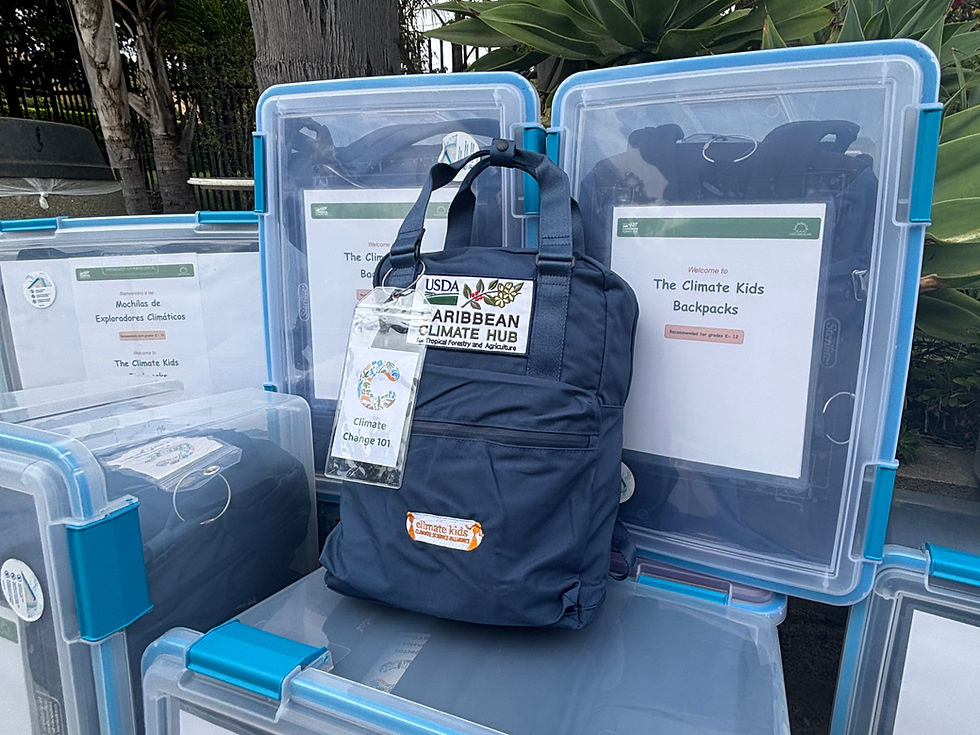Climate Science and Atmospheric Chemistry Traveling Trunk Undergoes Major Expansion
- Climate Kids HQ

- May 21, 2020
- 2 min read
In early Spring, the Climate Science Alliance was excited to partner once again with the NSF Center for Aerosol Impacts on Chemistry of the Environment (CAICE) to expand the Climate Science and Atmospheric Chemistry Traveling Trunk to ten CAICE locations on campuses throughout the United States!

In early Spring, the Climate Science Alliance was excited to partner once again with the NSF Center for Aerosol Impacts on Chemistry of the Environment (CAICE) to expand the Climate Science and Atmospheric Chemistry Traveling Trunk program to ten CAICE locations on university campuses throughout the United States!
This trunk brings to life aerosols - one of the most poorly understood components of Earth’s atmosphere - and their impact on our lives and the changing climate, while inspiring and encouraging students to do their part to help protect the earth. Through science, art, and storytelling activities, students will gain an understanding of the current science behind atmospheric chemistry, the impact of aerosols on climate and public health, and how scientists are working to better understand the issues that we face at the intersection of these topics.

Climate Kids Traveling Trunks provide resources educators need to teach climate science in the classroom. Each trunk includes background information, lesson plans, powerpoints, activities, and materials to increase climate literacy for K-12th grade youth. Climate Kids trunks feature interactive and hands on science, storytelling and art curriculum aligned to Next Generation Science Standards.
With the help of CAICE graduate students at UC San Diego in early March, the Climate Science Alliance was able to create ten new trunks, which will be sent to ten CAICE locations on university campuses throughout the United States.

Note: The Traveling Trunks were assembled in early March of 2020, before the COVID-19 pandemic. Both the CAICE and Climate Science Alliance teams are excited to send these Traveling Trunks to campuses when appropriate and safe to do so. Stay tuned for updates!
About CAICE: The NSF Center for Aerosol Impacts on Chemistry of the Environment (CAICE) focuses on improving our understanding of how aerosol particles impact the environment, air quality, and climate. Led by Dr. Kimberly Prather, UC San Diego Distinguished Chair in Atmospheric Chemistry, the Center’s goal is to understand critical details regarding the chemistry of aerosols.
CAICE tackles the grand challenge of elucidating how the chemical complexity of atmospheric aerosol particles impacts our atmosphere and climate. One important type of aerosol, sea spray, has tremendous chemical variability depending on ocean chemistry, biology, and physical factors such as waves and wind. CAICE has established a unique ocean-atmosphere interaction facility that replicates natural sea spray aerosol in a controlled setting, allowing for detailed fundamental studies of aerosol reactions.
CAICE has assembled an interdisciplinary team of scientists to accomplish this task: atmospheric, physical, biochemistry, analytical, and organic chemists, along with oceanographers and marine biologists. In addition to conducting innovative research, the CAICE team is dedicated to improving science education and impacting the public through outreach.
The Climate Science Alliance is excited to continue to build our strong partnership with CAICE to support their education and outreach efforts and unite Climate Kids programming with the topic of Atmospheric Chemistry and Aerosols.
To learn more about the NSF Center for Aerosol Impacts on Chemistry of the Environment (CAICE), please visit: www.caice.ucsd.edu





Comments